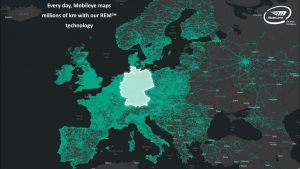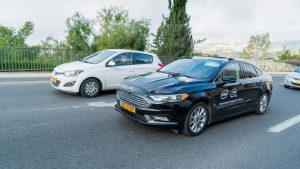Jerusalem-based Mobileye, the developer of driver assistance systems acquired by Intel Corporation for USD 15.3 billion in 2017, is set to test its self-driving vehicles in regular traffic in Germany after receiving an automated vehicle (AV) testing permit recommendation from the country’s independent technical service provider TÜV SÜD.
The permit will allow Mobileye to perform AV testing in urban and rural areas across Germany as well as the Autobahn, the federally controlled extensive network of limited-access freeways, at driving speeds of up to 130 kilometers (80 miles) per hour.
The tests will begin in and around Munich with plans to expand to other areas. The tests in Germany build on Mobileye’s existing program in place in Israel, where the Intel company has been testing its autonomous vehicles for at least two years.
Mobileye indicated that it expects to launch open-road testing in more countries before the end of the year.
Earlier this year, the Israeli-founded firm announced two new partnerships for the deployment and testing of its autonomous vehicle technologies including a long-term cooperation to test and deploy its autonomous taxi (robotaxi) mobility solutions in Daegu, South Korea, and an agreement with SAIC, a leading Chinese OEM, to use Mobileye’s Road Experience Management (REM) mapping technology to map China for L2+ advanced driver-assistance systems deployment to prepare the country for autonomous vehicles.
Mobileye said it has already laid the foundations with REM and is creating high-definition maps of worldwide road infrastructure as the basis for safe autonomous driving. Millions of kilometers of roads across the globe are mapped every day with the REM technology, the company said. In addition, data from 25 million vehicles is expected to be collected by 2025, in cooperation with various auto manufacturers.

Mobileye is also set to roll out its robotaxi shuttle fleets this year in Paris, following a deal with RATP Group (Régie Autonome des Transports Parisiens), and in Tel Aviv (in partnership with Volkswagen and Champion Motors), in addition to Daegu. The company also recently announced a collaboration with one of the largest transport operators in Southeast Asia to test robotaxi services in Japan and Taiwan by 2021, with plans to launch fully self-driving ride-hailing and ride-sharing mobility services in 2023.
In Germany, Mobileye said it is one of the first non-OEM companies to receive a permit to test AVs on open roads in the country, where such test drives have primarily taken place in simulated environments.
“Mobileye is eager to show the world our best-in-class self-driving vehicle technology and safety solutions as we get closer to making safe, affordable self-driving mobility solutions and consumer vehicles a reality,” said Johann Jungwirth, VP of mobility-as-a-service (MaaS) at Mobileye.
“The new AV permit provides us an opportunity to instill even more confidence in autonomous driving with future riders, global automakers, and international transportation agencies,” he added.

To obtain the permit, Mobileye had to undergo “a series of rigorous safety tests and provided comprehensive technical documentation,” Intel said in a statement, including a detailed hazard analysis, vehicles safety and functional safety concepts, and proof that the cars can be safely integrated into public road traffic.
This was made possible with Mobileye’s unique self-driving system (SDS) for MaaS and consumer autonomous vehicles, Intel said. The system is comprised of “the industry’s most advanced vision sensing technology, true redundancy with two independent perception sub-systems, crowd-sourced mapping in the form of Road Experience Management (REM), and its pioneering Responsibility-Sensitive Safety (RSS) driving policy.”
The project comes on the heels of Intel’s acquisition of Israeli MaaS solutions company Moovit for approximately USD 900 million two months ago. Intel indicated at the time that the deal was made to help Mobileye accelerate its autonomous driving solutions and bring it closer “to achieving its plan to become a complete mobility provider, including robotaxi services, which is forecast to be an estimated USD 160 billion opportunity by 2030.”
Founded in 2012, Moovit has grown its user base to over 800 million people in 3,200 cities, who use its mobile and web app. In addition to its public transportation data features, Moovit’s other mobility options are quite extensive and include ride-hailing companies, car-sharing companies, station-based bike-share systems, dockless bikes, scooters, and mopeds. The company also sells transit data analytics to municipalities and public transport operators through its Smart Transit Suite, and collects more than 6 billion data points daily about traffic flow and user demand.
Together, Intel said Mobileye and Moovit will start demonstrating full end-to-end ride-hailing mobility services based on Moovit’s mobility platform and apps using Mobileye’s AVs.

Intel said this strategy “offers society and individuals solutions to today’s major social costs of transportation,” namely minimizing traffic congestion, reducing emissions, and giving people equal and affordable access to mobility.
“The goal is to make mobility safe, accessible, clean, affordable, and convenient, so that people can travel efficiently, flexibly, and smartly from Point A to Point B. All means of transport—from public transport to car and bike-sharing services to ride-hailing and ride-sharing with self-driving vehicles—will be bundled within one service offering of Moovit and Mobileye, smartly managed by Moovit’s mobility intelligence platform,” according to the company statement.
Mobileye’s plans to revolutionize mobility
Mobileye is a growth engine for Intel as it “transforms for a world where the exponential growth of data fuels demand for technology solutions that can process, move, and store more data faster,” the multinational has said.
In a post in May following the Moovit acquisition, Amnon Shashua, the co-founder of Mobileye and senior VP at Intel, said that the mobility supply is “shaping into three types of players, including traditional public transit operators who offer most of the urban bus and rail services, transportation network companies such as taxi operators and ride-hailing companies, and the emerging driverless ride-hailing operators.”

“All have different strengths and weaknesses, needs, and business models, but a common aim: All players are striving for automation as the most affordable and efficient transportation method of the future,” he added.
Shashua laid out three steps and models as part of Mobileye’s multimodal XaaS (anything-as-a-service) strategy: “First is vehicle-as-a-service (VaaS), where we will sell or lease the self-driving vehicle for the customer to operate. In the second model, rides-as-a-service (RaaS), we will provide rides to fleet operators, including the fleet operations. Both models are designed to meet the business needs of the different transportation providers and will be amplified with a strong mobility intelligence layer (optimization, demand analysis, etc.) that will enable maximal utilization. In the third model, MaaS, Mobileye will deploy its own robotaxi service.”
Shashua acknowledged that the tasks ahead would not be easy and required “the best self-driving technology out there, along with vast operational know-how, valuable data, and a customer-facing infrastructure.”
This article first appeared in NoCamels, which covers innovations from Israel for a global audience.

